#forgets he’s a world famous Rock’n’Roll star
Explore tagged Tumblr posts
Text
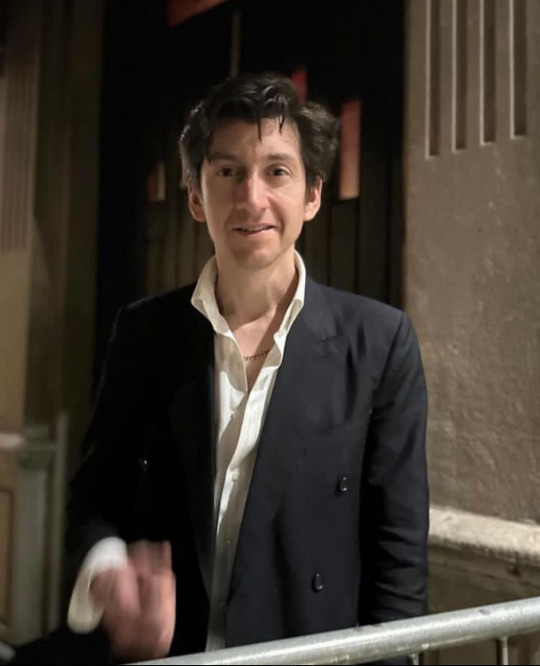
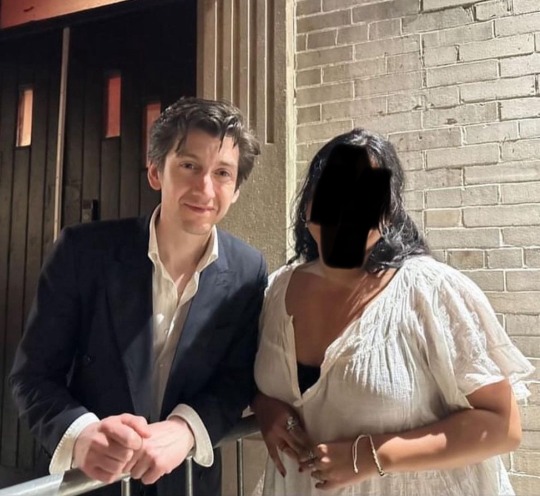
Via

Oh hi Zackery so how’s that stunning documentary coming along


Via zacharriflint
#08/05/2024#alex turner#Fontaines DC#New York#he’s so sweet#oh my the video#like he just genuinely looks interest in whatever the fans were telling him#like honestly listening and paying attention I adore him#like he’s so fuckin famous and still every single interaction the fans report that he was so sweet and kind and polite#he’s alive; got hair; got style and looks so happy and relaxed though a bit surprised so many wanted to speak to him 😂 feel like he often#forgets he’s a world famous Rock’n’Roll star#like that man is 38 years old and somehow he still looks so young#he’s so fucking babygirl#he keeps me fucking sane from time to time
6 notes
·
View notes
Text
I got my hands on a copy of the new Euroman for @idontfindyouthatinteresting, and I took the opportunity to translate some of the interview as well. I tried scanning the article, but my scanner is broken, so you’ll have to make due with iPhone pics of the photos until someone with a working scanner gets in the game.

Rest of the photos and the interview under the cut.

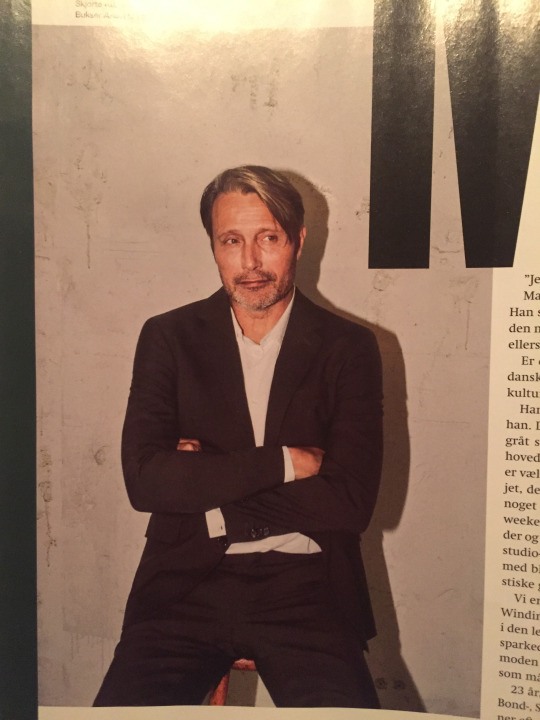
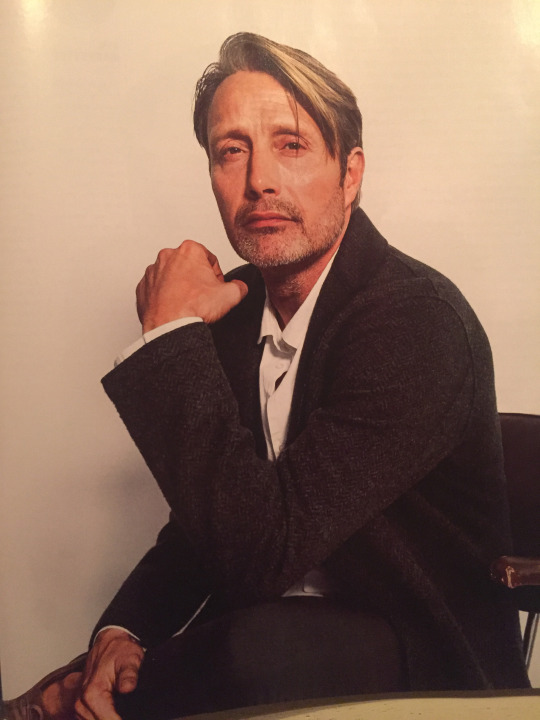
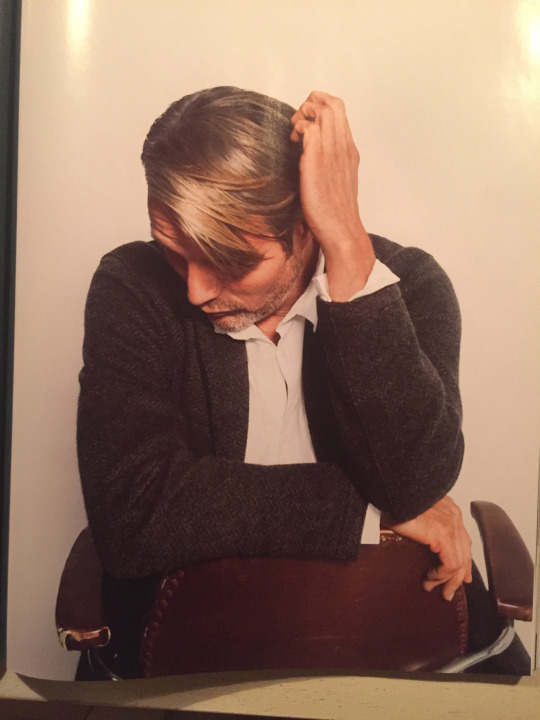
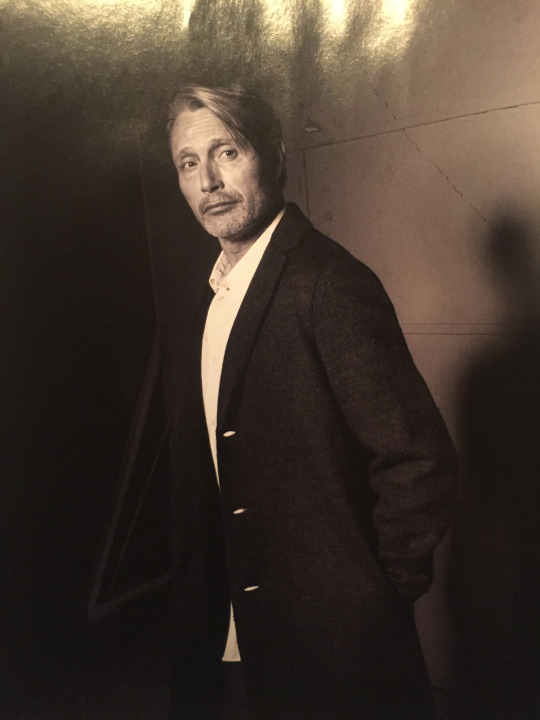
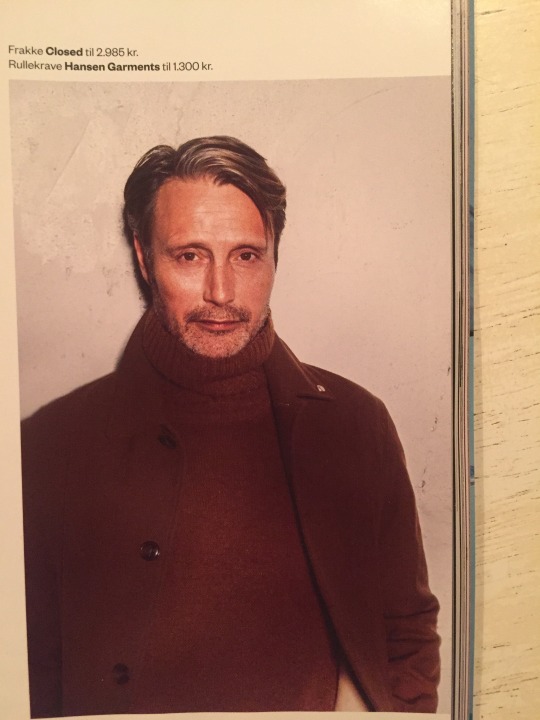
The interview itself was a monster of a thing with lots and lots of flowery descriptions of random scenery, so I cut it down to just the questions, though a few highlights of the rest include:
When he was knighted the Queen of Denmark told him she liked Flame and Citron and he was like ‘fuck yeah’.
He rolls up with his classic bedroom eyes, mismatched tracksuit, and worn sneakers, and just needs a smoke before they go in.
The reporter thinks it’s pointless for a hairdresser to style Mads’ hair because it’s amazing already.
Mads goes around introducing himself to everyone in the room with “Hi. My name is Mads.”
He speaks very fast in Danish.
Onward with the questions:
Q. You were an unknown dancer for ten years before you became an actor. In terms of staying grounded, has it been an advantage for you that you had your breakthrough at such a mature age?
A. Yes, I think so. I probably wouldn’t have had problems staying grounded even if I had been 20 years old. But I think it’s harder for a 17-year-old today, where you can have your breakthrough on a whole different platform and gain three million followers, or whatever the hell they have. It’s obvious that if everyone thinks you’re cool, and you’re told so a bit too often, then you start thinking ‘yeah, I am. I’m cool’. It’s easier to handle being recognized in the street when you’re 32, than when you’re 17. I think.
Q. Your James Bond co-star Jesper Christensen has said that he can no longer enter a public space and just sit there observing, because everyone is always staring at him. He can no longer gain inspiration for his work from real life– from ‘ordinary people’ – like he used to. Do you feel the same way?
A. It’s a terrible loss. It’s not that I’ve always been preparing to be an actor, but I’ve always been curious. Even as a child, I would sit in different places and watch what was happening over there, human behavior, the way they looked and the way they walked. Always. And too often I started copying people when I saw them. I would sit just like them for a while, just to try how it felt. That’s over now. Whenever I’m out somewhere, 50 people are sitting around staring at me. Then I have to worry about scratching my nose, and there’s 40 camera phones in my face. Then I have to go to a different country.
Q. Don’t you get recognised abroad?
A. They know me around the world to various degrees. There are definitely many places where they don’t care at all, but James Bond, Star Wars, and Marvel movies, all of which I’ve starred in, have a great reach. The happy result of this is that people become curious about me as an actor, so I’m often stopped abroad because people know me from The Green Butchers or The Hunt. That’s super cool.
Q. Is it important for you to get recognition in the business? And do you?
A. A foreign colleague whom I have great respect for told me that he and three friends would sit down and watch the Pusher trilogy every weekend. That made me happy. Recognition from colleagues is important. Recognition from yourself is just much more important. You can get into a cycle where you go around constantly patting each other on the back because you need it so badly in my line of work. We’re judged all the time. It’s really hard, and so we probably have a tendency to praise each other more than we should. You should be happy when other people think what you’re doing is great, but you need to remember to consider what you think about it personally. ‘Was this what I wanted? Yes, okay, fine. Next time I might go in this direction instead.’ That’s important. And it’s the same if what people are saying about you sucks. There are many opinions out there. And if you start reading on social media you’ll never get to bed. You should stay away from that.
Q. Where do you find material and inspiration when you can’t go people-watching anymore? Do you have a memory bank you draw from?
A. Probably. I can also sit and watch people on screen, television and so on. But inspiration should primarily come from the script and the director. But I really miss sitting around and watching other people, and I certainly miss them not staring at me. I don’t try to hide though, I never wear a cap or anything. Sunglasses annoy the hell out of me, so I don’t use those at all. Luckily I‘m forgetful: I walk outside in the morning and don’t spend a second wondering how it’s going to be when I arrive somewhere – whether I’ll be recognized, I mean. That’s not just something I’m saying. I get in my car and drive somewhere and enter wherever I’m going, and don’t think about it at all. It’s not until people do this (Mads widens his eyes and turns his head) and do a double check that I’m reminded what it’s like. And that’s good, because otherwise I’d never leave the house.
Q. But you haven’t always been famous – in Hollywood you were a total unknown in the beginning. As the unknown from a small country did you have to work to earn the respect from people around you when you did your first foreign films?
A. I never consciously considered that I had to do something to make them listen to me. If I thought something could be done differently, I haven’t been afraid of going up to people and telling them. Obviously it’s not like it is in Denmark where I can just call Thomas Vinterberg up and say ‘hey, I just had an idea, won’t you come over?’ A Hollywood director on a big movie has maybe 30 actors on his list and everybody wants something from him, so the scale is different. But I still speak up, if there’s something wrong, and only if I’m serious about it. If I’m not serious about it, we just start working on whatever we’re doing.
Q. Are you treated differently on set now that you’re a bigger star?
A. Yes. I was very surprised with first time I was part of a large foreign production. We were on set, and I approached someone from the light-crew to ask about something. Then he looked down at the ground and didn’t answer. Turns out there had been this big name actor, whose name I can’t be bothered to mention, who had just done a movie with this crew, and the crew was under strict orders to never look this actor in the eyes. So there I was, a product of all this. Those were the kind of things I had to get used to. Luckily I found out that if I just focused on my work in the same way I usually did my surroundings would relax pretty quickly. They care more about things abroad than they do in Denmark. I’ve had some pretty weird experiences on foreign jobs. For example, I’m often assigned a so-called handler. Someone who meets me at the airport and helps with checking in and stuff like that. Which is fine, if you’re in Beijing and your have no idea where you’re going. But on foreign gigs I’ve also tried being a assigned a handler at Copenhagen Airport, who is supposed to follow me and help me. That’s pretty absurd, since I’ve checked in 2000 times before in Copenhagen and know how to do it. A handler is always dressed really nicely too, so everybody at the airport ends up staring at me even more. That’s a weird service.
Q. How about the treatment you receive from the other stars, or the business as a whole? How do you experience the hierarchy in Hollywood?
A. When I worked with Benedict Cumberbatch in Doctor Strange and with Daniel Craig in Casino Royale it was their first big films as well, so the hierarchy wasn’t crazy. I’ve been spared from meeting someone abroad who was a real hot shot or just tired of doing what they were doing. There are plenty of people with attitude, plenty of large personalities, but I’ve met very few proper divas who are impossible to work with. The few I have met have been here at home. It’s actually a myth, that this is a diva business. If you did an inquiry and compared us to bus drivers or doctors for example, I think actors would rate much lower than them on the diva-scale. We’re very conscious about not behaving like divas, so everyone tries to act natural. Nobody wants to be branded like that. And when one finally comes along, which obviously happens, then it’s so exciting, and it sounds like the whole business is infected with them. But holy shit, man, how many little kings in their little kingdoms have you met driving the 8 Line?
Q. Your generation, which had its breakthrough 20-25 years ago, has taken up a lot of space back here at home and internationally. You’ve become…
A. You can say ‘old’. We’ve gotten bloody old.
Q. Has it only now become clear how much space you take up?
A. No. I think it was obvious from the beginning. We were a generation that grew up with a big fascination for certain foreign films. Many of us had Martin Scorsese and Francis Ford Coppola in common. There weren’t’ many Danish films we could relate to. [here follows a whole bit about Danish movie history that no one outside Denmark will care about, so I’m skipping it] We felt like we were living in the 50’s. We were watching foreign movies like ‘Taxi Driver’ and saying to each other ‘is this from 1975?’ What have we done in Denmark this year? It was crazy. Completely crazy. Obviously something had to be done. And it was. We grew in different directions but suddenly the gap wasn’t so wide… I mean, we were no longer being told what it was like to be a teenager by an 88 year old director. We were the same age and we communicated directly. Just like Scorsese and De Niro in the 70’s. Same age, let’s go, rock’n’roll. Obviously it’s hard for the next generation, who comes after us, to just change things as well. Because we did the right thing. So now they either have to copy that approach, or improve it, or come up with something completely new. It was easier for us, if I’m being honest. We said ‘Hey, have you seen this before?’ and people went ‘No, we haven’t. Cool!’ But we had to do it. And we were allowed to do it, first and foremost. Some things went wrong, some things went right. But it was really important.
Q. You and your brother both seem like you’re very down to earth. Is that a result of growing up on Nørrebro?
A. Yes, I guess. No… Where the fuck did Pilou (Asbæk) grow up? He has some higher ‘a’s than I do, when he taaaaalks. But he’s damn well down to earth too. So I think it’s a Danish thing. If you try to rise a bit above other people, it won’t be very long until you’re pulled back down.
Q. Have you tried it?
A. No. As a Danish person it’s very hard to demand only to be served the yellow M&Ms without people laughing at you.
Q. Can’t it be limiting, that we’re like that? That everything has to be so down to earth.
Pause.
A. It’s funny, because we’re different than the Swedish. They have a whole different way of engaging with their stars. The Swedish are down to earth too. But when Swedish actors sit down to talk like this, like I’m doing now, and a journalist enters the room, that they start (Mads straightens and adopt a somber tone) speaking like this. And the things they say become great philosophy. They also start to move (he waves his arm theatrically) like they were on stage at the Royal Theatre. When I see that I think ‘what the fuck just happened?’. The Swedish write with great reverence about their stars as well. They have a huge amount of respect for what they give us. Swedish stars have a whole different status in society than we do in Denmark. They like putting things up on a pedestal, and they’re allowed to do that in a totally different way then we are. You can’t do that here. And thank God for that. But you can also say, that in Denmark you don’t always respect people for what they can do. Sometimes people will go ‘Fuck man, I can do what Caroline Wozniacki does. She’s the worst I’ve ever seen.’ Okay? I mean, it’s nice that we’re down to earth in Denmark. But it’s grotesque to say that ‘What Wozniacki does, I can do just as well.’
So that’s how I spent the last five hours of my life...
254 notes
·
View notes
Text
“Fogerty turned Helsinki into Woodstock for one night”

HELSINKI - There’s something special in listening John Fogerty talk about his own experience at Woodstock music festival, roughly 50 years ago to this date. For a younger generation of rock’n’roll fans, including myself, Woodstock remains as this mystical gathering of drug-filled, life loving group of young people, who believed they were changing the planet for better.
Fogerty himself simply referred to this generation as “us, the kids”. Now, 50 years later the world has surely changed - for better or worse? - but the music of the 1960’s and 70’s has survived the test of time. On a cloudy summer night in Helsinki, John Fogerty brought the spirit of Woodstock alive.
It has been a while since CCR surfaced on to the American rock’n’roll scene like a wildfire and took over the record sales. You think the moon landing was long ago? As stated in the opening video of the show, “Bad Moon Rising” is exactly as old as the moon landing - 50 years. Plus 10,000 people gathered at Hartwall Arena got a glimpse of what it was like at Woodstock on that August weekend.
Half-million people, creating a sea of people that stretched as long as the eye could see. The show itself kicked off with “Born on the Bayou”, continuing straight into “Green River”. The first half-hour also included a strong version of old classic “Susie Q” and evergreen “Who’ll Stop the Rain”.
Fogerty’s “50-year trip” -tour celebrates the entire five-decade long trip all the way from the days of CCR, all the way to his solo days - not forgetting some of the other greats of the 1960’s and 70’s. For a musician, like Fogerty, it isn’t easy to “sacrifice” 30 minutes from the set for the cover songs. In this case though, covers are an integral part of the show and the trip itself. Fogerty describes the songs of the late 1960’s as the songs “with a deeper meaning”.
Joe Cocker’s version of “With a Little Help From My Friend” is a tribute to the legend himself, but also to the influence of The Beatles. Fogerty’s son, Shane, got a chance to shine in the spotlight, covering the famous Jimi Hendrix-rendition of “The Star-Spangled Banner”. Cover part of the show ends with John Lennon’s “Give Peace a Chance”, that works - surprise, surprise - well with the whole Woodstock theme.
While a part of the Woodstock-generation, Fogerty’s strong points were never tied solely into the culture of “freedom” and the ideas of strong liberalism. For him, rock’n’roll has always been the closest to his heart. It’s easy to see that - still at the age of 74 - he enjoys playing and honestly, who wouldn’t? Fogerty has written hours and hours worth of hits, that tap straight into the heart of American rock’n’roll. 50 years later, artists like Fogerty are still the bedrock of the greatest era of entertainers. Going into the summer of 2019, the feel and spirit of Woodstock are alive and well.
Setlist:
1. Born on the Bayou
2. Green River
3. Lookin’ Out My Back Door
4. Susie Q
5. Who’ll Stop the Rain
6. Hey Tonight
7. Up Around the Bend
8. Blueboy
9. Rockin’ All Over the World
10. I Heard It Through the Grapevine
11. With a Little Help From My Friend
12. Long as I Can See the Light
13. My Generation
14. Good Golly Miss Molly
15. Everyday People
16. Dance to the Music
17. Give Peace a Chance
18. The Star-Spangled Banner
19. Run Through the Jungle
20. Keep on Chooglin’
21. Have You Ever Seen the Rain
22. Down on the Corner
23. The Old Man Down the Road
24. Fortunate Son
Encore:
25. Bad Moon Rising
26. Proud Mary
0 notes
Text
New Post has been published on Vintage Designer Handbags Online | Vintage Preowned Chanel Luxury Designer Brands Bags & Accessories
New Post has been published on http://vintagedesignerhandbagsonline.com/fashion-unfiltered-how-2017-became-the-year-of-versace-fashion/
Fashion, unfiltered: how 2017 became the year of Versace | Fashion
In 1997, Gianni Versace was murdered on the steps of his Miami Beach home. His grief-stricken sister, Donatella, suddenly found herself in charge of the family company. Twenty years later, she has chosen to take this anniversary and make it extraordinary, hijacking the style agenda to the extent that fashion journalists have been calling 2017 the year of Versace. She has designed a tribute collection inspired by Gianni’s archives, announced a scholarship in her brother’s name at Central Saint Martins and, in September, in a fashion coup for the ages, reunited Gianni’s supermodel crew – Helena Christensen, Cindy Crawford, Naomi Campbell, Carla Bruni and Claudia Schiffer – for a catwalk finale that melted the internet.
It’s not over. On Monday night, she received a major accolade at the Fashion awards. On Tuesday, she will open a new Versace store on Sloane Street in London. In the light-filled salon where we meet, she is warm and smiley, talking me through a set of unpublished photographs by Doug Ordway that will be exhibited in the store. A lot of her year has been spent poring over old images and old creations, opening up the archive – a 10,000 sq ft storage facility in Novara, near Milan – and examining Gianni’s most famous creations for the first time since his death. “Not in a sad way,” she says, “but a very positive way. I saw what a genius my brother was. To me, he was my brother, but to the rest of the world – such a genius.”
Authentic feel … Cindy Crawford in the early 90s. Photograph: Doug Ordway/Versace
Even the names of the archive collections, produced between 1991 and 1995, speak of another, more glamorous age: Vogue, Warhol, My Friend Elton, Icons, Baroque. The pictures she shows me are from that time, too, and present the supermodel era exactly as you would want. Here is Bruni, a future first lady of France, dancing with abandon in thigh-high patent boots. Here is a babyfaced, never-off-duty Crawford, smouldering for the camera as she queues backstage. Here is Christy Turlington, running down a beach, wearing only shimmering sequins. Compared with the unsmiling models who have walked the catwalk since, and the airbrushed campaign images and omnipresent filtered Instagram photographs we have grown used to, these pictures feel authentic (however liberally doused in hairspray the models are).
They bring back great memories, says Donatella. “This was the period that fashion became famous,” she says. “It was the beginning of fashion becoming pop culture, of being associated with music and rock’n’roll. Those two worlds were really in contact with one another. When something starts to happen, that is the most exciting moment. It was a huge change. The 90s was a huge change in fashion.
“My brother, of course, was the designer; I was working very closely with him all my life. But I started the relationship with the models that Gianni made ‘super’.” What “super” meant, she says, was showing personality. “Before that, I don’t think many designers let models have personality, nor after. The models should wear the clothes, be very serious, not smile, look in front of you, almost no soul. This was totally opposite: it was about the girls, what the girls were thinking, who they were dating. It wasn’t just about the clothes, but about who was wearing the clothes.”
Backstage sounds a hoot. She speaks in her inimitable, strongly Italian accent, one anecdote rolling into another, about models arriving six hours before the show because they all wanted François Nars, rather than his assistant, to make up their faces. She talks about the models swapping clothes after they had been allocated outfits and thinking: “I don’t know how I’ll explain this to Gianni.” She adds: “What I remember was the professionalism of these women, and the competition, which I think was very good and healthy. Everyone wanted to be better than everyone, not in a bad way.
First lady of fashion … Carla Bruni in a 1991 Versace advert. Photograph: Doug Ordway/Versace
“My brother was very concentrated about the clothes. I was, too, but my role was to make the girls feel like themselves in the clothes. Would they like it a bit longer or shorter? They were a soundboard.”
Fashion modelling is only just getting exciting again, she says, thanks to technology. “There are two generations of fashion for me: the one before the internet and the one after the internet.” Between the supermodels and now, she says, “was a moment of flatness. Now you could do this picture backstage again – there are people with enough personality there.” She likes the Instamodels, such as Gigi Hadid, who have become powerful thanks to their millions of followers on social media. “I think they are amazing. Very smart girls. Again, finally, we have girls who dare to stand out in the crowd.”
A fixture on the fashion calendar since 1989 (with the notable exception of 1998), the Fashion awards acknowledge and celebrate the finest design and style talent. The event, which is organised by the British Fashion Council, was known as the British Fashion awards until 2016, when it opened up to international fashion brands. It now has only a small number of Britain-focused awards.
The categories
Specific awards have come and gone – in 2003, for example, awards for sport, acting and music personalities were incorporated. Currently, the accolades up for grabs are: designer of the year; British designer of the year – womenswear; British designer of the year – menswear; accessories designer of the year; business leader; model of the year; British emerging talent – womenswear; British emerging talent – menswear and the Urban Luxe award. Additional awards – including the Isabella Blow award for fashion creator, the Swarovski award for positive change and the special recognition award – are normally announced before the ceremony.
Memorable moments
In 1997, designers John Galliano and Alexander “Lee” McQueen jointly took home the designer of the year award for the only time in the event’s history. Nearly 20 years later, in 2015, JW Anderson was named menswear and womenswear designer of the year – another first for the awards.
The venue
The awards called the Royal Albert Hall home for the first three years of its existence, before being celebrated at many of the capital’s other most famous landmarks, including the Coliseum, the Natural History Museum and the V&A. In 2016, it returned to its original Kensington Gore address; the plan is to keep it there.
Photograph: Richard Young/REX/Rex Features
Donatella talks about models’ ability to show their humanity as a type of female empowerment. Drawing parallels between models’ power and their treatment in the industry feels pertinent in the wake of the Weinstein revelations. Terry Richardson, who has worked with Versace, has been banned from working with Condé Nast International, while Bruce Weber, another photographer who has collaborated with the brand, has been accused of sexual harassment. The fashion industry is expected to be the next to see many of its titans fall. How does she feel about the wave of allegations against powerful men? She wishes they had come out earlier. “I am very happy they talked,” she says, “but if they came out earlier this thing would stop earlier. But I am very happy they came out.” Has she ever experienced sexual harassment? “No.” There is the first awkward silence of our conversation.
Letting loose … Helena Christensen modelling for the brand in 1991. Photograph: Doug Ordway/Versace
The 62-year-old’s Fashion awards gong is icon of the year and the hype around her company is enormous, so it is easy to forget the starting point: the horror of her brother’s murder and her first few years running the company, during which she was so shellshocked that she broke down in tears on the catwalk. Does she feel like an icon? “Yes,” she says abruptly, then laughs. “OK, should I be shy? No. This is not because I’m full of myself, but I think, in fashion history, I did a lot. I mean an icon in fashion, not an icon in general, in the world.”
I congratulate her on her self-belief. “Come on,” she says, “after all these years.” For her, an icon is “somebody who can inspire people. I think I can inspire because of my history, which is painful. My brother was killed. He was killed. He didn’t die of anything – he was killed. What I went through as a woman on my own to keep this company alive and overcome all the difficulties, and to be always compared to my brother, who was a genius, when I was not a genius in fashion, I was a different kind of person.” What she did, she says, was to feature rock stars – Prince, Madonna – before anyone else and to get Prince to soundtrack a show. “I’m not saying I cured cancer,” she says. “I am not afraid to go in the middle of the crowd and be one of them. I want to stand out from the crowd, for what I am saying first and also for the way I look. I’m not beautiful, but I have a look: blond hair, high heels, lots of makeup.”
If the look has felt cartoonish in the past, “that was really a shield, to hide myself behind this very cold person that nobody can come too close to me, because I was afraid to show my insecurity, my sadness and my despair for what happened. [It was] so that few people could come and see how I really felt.” Over the past five years or so, she says, “I’ve cut my hair shorter, I wear a bit less makeup – not that much less – [but] I never left the heels; that is something I can be proud of. I walked my whole life in high heels and never stumbled once.”
Her outlandish look has made her one of the few designers to become part of pop culture in their own right. It is one of the reasons why the Versace brand has inspired songs by Lady Gaga, Migos and Bruno Mars. It is why Etsy sells custom-made Donatella Versace dolls and countless T-shirts, phone cases and ringbinders emblazoned with her face. Clearly, she has a cult, camp appeal. Her fans recognise her as someone who uses glamour – not glamour in the sense of looking pretty for men, but in the sense of looking extraordinary – in the face of adversity.
This kind of celebrity brings its own problems. “Fame was not one of the things I was looking for,” she says. “It was more about being taken seriously and being in a good relationship with people I love.” Arguably, as a designer, Donatella never got the respect she deserved until this year. This is partly because the Versace brand is unashamedly form-fitting and glamorous, whereas a great deal of tastemakers expect serious fashion to look serious. The new London store is a case in point, all onyx and Fior di Bosco marble and lustre. The aesthetic of Donatella’s life sparkles, too: Google “Donatella Versace’s bathroom” to see what splendour looks like.
Model pro … Christy Turlington backstage in 1990. Photograph: Doug Ordway/Versace
Perhaps the biggest challenge is dealing with the fictionalised interpretation of Donatella, which has taken on a life of its own: this version appears as a recurring character on Saturday Night Live, played by Maya Rudolph; it is also embodied by Gina Gershon in the outrageous TV movie House of Versace, in which “Donatella” stashes cocaine in a mascara tube. In January, Ryan Murphy’s American Crime Story: The Assassination of Gianni Versace will be shown on the BBC. The trailer is violent and flashy and seems to suggest that Gianni knew his murderer – the serial killer Andrew Cunanan – which has never been confirmed. Penélope Cruz, who has often worn Versace, plays Donatella; she has said that she spoke “a little bit” with the designer while preparing. “I needed that conversation,” she said. “I really hope that, when she sees the show, she’s going to be happy.” When I ask Donatella about it today, though, she doesn’t seem happy. “I don’t discuss fiction,” she says. So it is a fiction to you? “It is fiction,” she says, her eyes widening for emphasis.
I bring up millennials, the consumer group the industry is targeting most fervently. Millennials are all many designers talk about backstage, particularly in Milan. In Italian fashion, the charge has long been that so many houses have been run for decades by the same designers or dynasties (Armani, Prada, Versace, Missoni; even relative newcomers Domenico Dolce and Stefano Gabbana are 59 and 55) that the scene has become stale. There have been rumours swirling around Versace for the past year or two that Riccardo Tisci, formerly of Givenchy – or Virgil Abloh of Off-White or Kim Jones of Louis Vuitton – might be in line for Donatella’s seat. That may be the case one day, but this year the conversation has shifted dramatically. In many ways, Donatella’s approach to millennials and social media feels remarkably modern – and not only because she has 2 million followers on Instagram (in typically understated style, when she joined the app in 2015, a press release was issued; ever savvy, in her first post, she posed with Gigi Hadid).
This year, she says, has been “a rollercoaster of emotion. Not just that day [of the supermodel reunion show], but preparing for the show, going to the archive and seeing things that I last saw 20 years ago, before Gianni’s death. I never had the courage to go back there, because it was so painful, but I found the strength.” She did it, she says, “for the young generation who didn’t know, who weren’t born when Gianni was alive. I want them to know why Gianni was so important and what Gianni was about.” And to tell her side of the story? “To show them how relevant Gianni is today. No story, no filter.”
The new Versace store is at 179 Sloane Street, London; the Doug Ordway exhibition is open now
Source link
1 note
·
View note